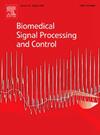Electrooculography signal generation with conditional diffusion models for eye movement classification
IF 4.9
2区 医学
Q1 ENGINEERING, BIOMEDICAL
引用次数: 0
Abstract
Electrooculography (EOG) is a biosignal that encodes the directional information of eye movements and is widely used in eye-tracking applications and human-computer interaction. These applications provide intuitive, accessible interfaces, making EOG valuable as a communication aid. Among these applications, eye writing—an approach in which users draw characters using eye movements—is distinguished for its ability to convey significantly more information than traditional methods. This technique has potential applications for individuals who rely on eye movements for communication, including those with amyotrophic lateral sclerosis. However, achieving high accuracy in eye writing typically requires deep learning models constrained by ethical and legal challenges in collecting large EOG datasets. In this study, we developed a diffusion-model-based generative framework for eye-written character recognition under limited-data conditions, addressing challenges in both accuracy and data availability. The model was implemented using conditional vectorized class information to further increase the diversity of the generated data by indicating the class. The effectiveness of the proposed method was assessed through visual representations of generated signals and comparison of classification accuracies. The model outperformed the generative adversarial network in terms of the visual quality of generated data. It also achieved classification accuracies of 94.63% for Arabic numerals and 80.36% for Japanese Katakana strokes when trained with ninefold data at intermediate steps. Despite having significantly more parameters, it achieved shorter inference time than TimeGAN, further demonstrating computational efficiency and feasibility. Additionally, adapting the proposed method to other bioelectric signals demonstrates significant potential, suggesting a flexible framework for future biosignal research and applications.
用条件扩散模型生成眼电信号进行眼动分类
眼电图(Electrooculography, EOG)是一种编码眼球运动方向信息的生物信号,广泛应用于眼动追踪和人机交互等领域。这些应用程序提供了直观、可访问的界面,使EOG作为一种有价值的通信辅助工具。在这些应用程序中,眼写——一种用户通过眼球运动来绘制字符的方法——以其比传统方法传达更多信息的能力而闻名。这项技术对依赖眼球运动进行交流的人有潜在的应用,包括那些患有肌萎缩性侧索硬化症的人。然而,在收集大型EOG数据集时,通常需要深度学习模型,这些模型受到道德和法律挑战的限制。在这项研究中,我们开发了一个基于扩散模型的生成框架,用于有限数据条件下的眼写字符识别,解决了准确性和数据可用性方面的挑战。该模型采用条件向量化类信息实现,通过指明类进一步增加生成数据的多样性。通过生成的信号的可视化表示和分类精度的比较来评估所提出方法的有效性。该模型在生成数据的视觉质量方面优于生成对抗网络。在中间步骤九重数据训练下,对阿拉伯数字的分类准确率为94.63%,对日文片假名笔画的分类准确率为80.36%。尽管具有更多的参数,但其推理时间比TimeGAN短,进一步证明了计算效率和可行性。此外,将所提出的方法应用于其他生物电信号显示出巨大的潜力,为未来生物信号的研究和应用提供了一个灵活的框架。
本文章由计算机程序翻译,如有差异,请以英文原文为准。
求助全文
约1分钟内获得全文
求助全文
来源期刊

Biomedical Signal Processing and Control
工程技术-工程:生物医学
CiteScore
9.80
自引率
13.70%
发文量
822
审稿时长
4 months
期刊介绍:
Biomedical Signal Processing and Control aims to provide a cross-disciplinary international forum for the interchange of information on research in the measurement and analysis of signals and images in clinical medicine and the biological sciences. Emphasis is placed on contributions dealing with the practical, applications-led research on the use of methods and devices in clinical diagnosis, patient monitoring and management.
Biomedical Signal Processing and Control reflects the main areas in which these methods are being used and developed at the interface of both engineering and clinical science. The scope of the journal is defined to include relevant review papers, technical notes, short communications and letters. Tutorial papers and special issues will also be published.
 求助内容:
求助内容: 应助结果提醒方式:
应助结果提醒方式:


